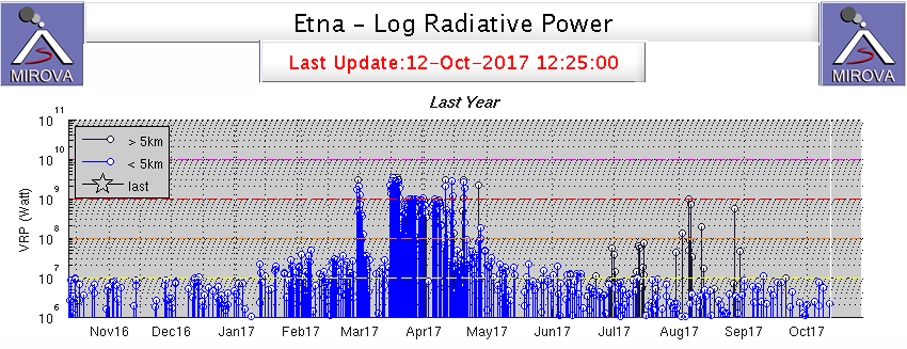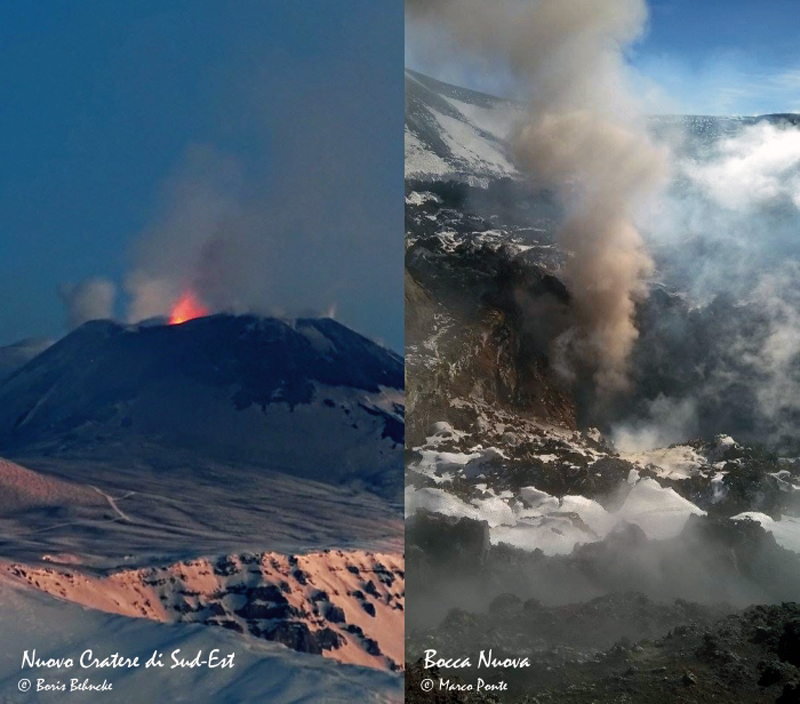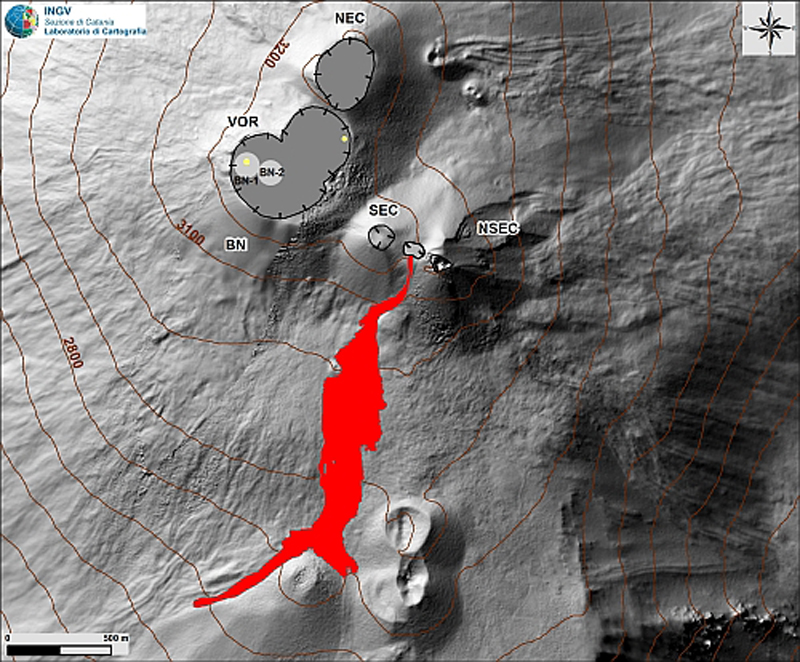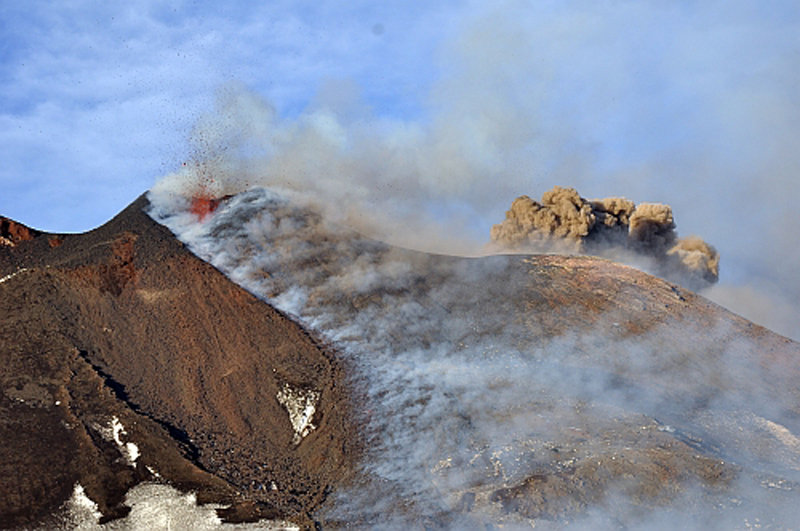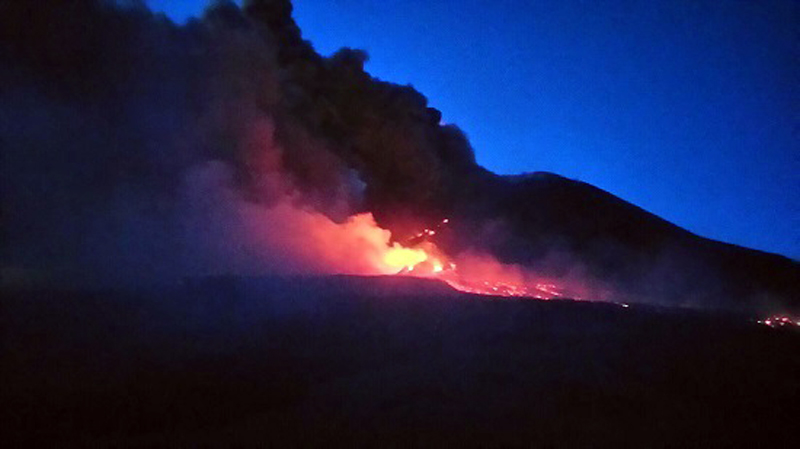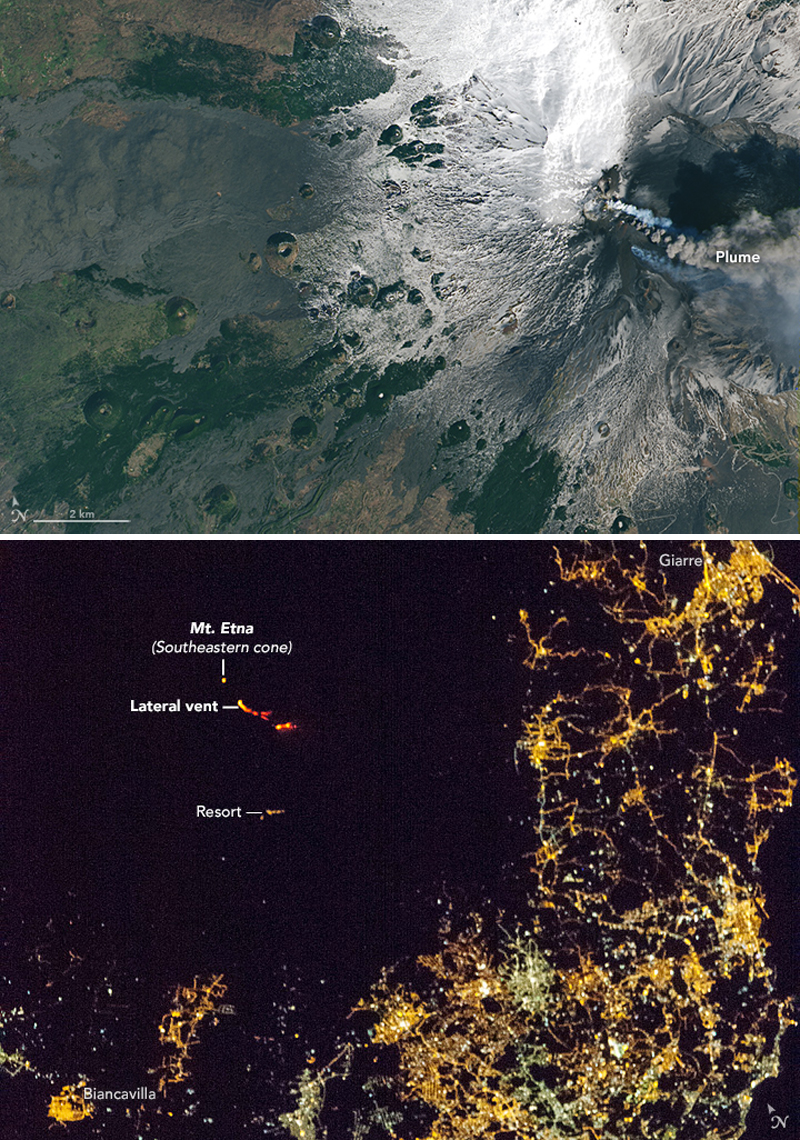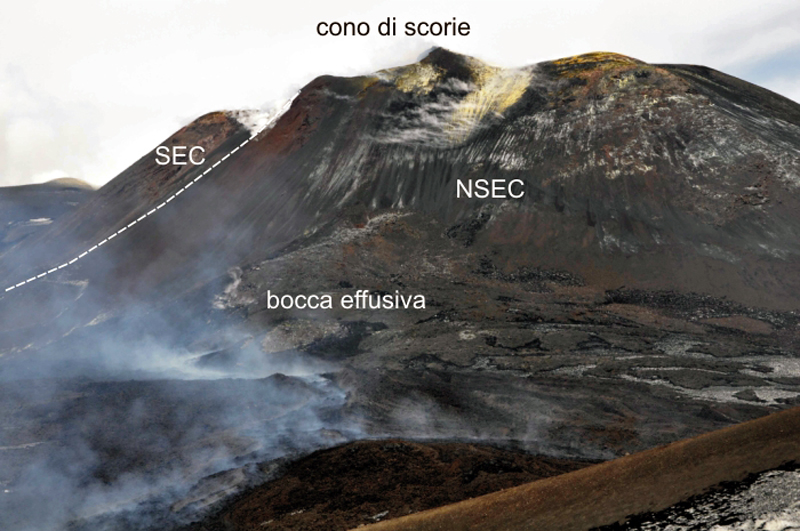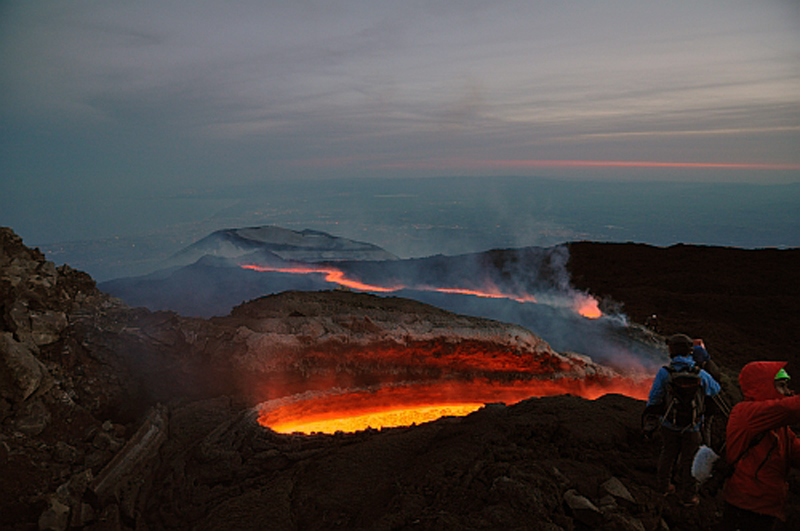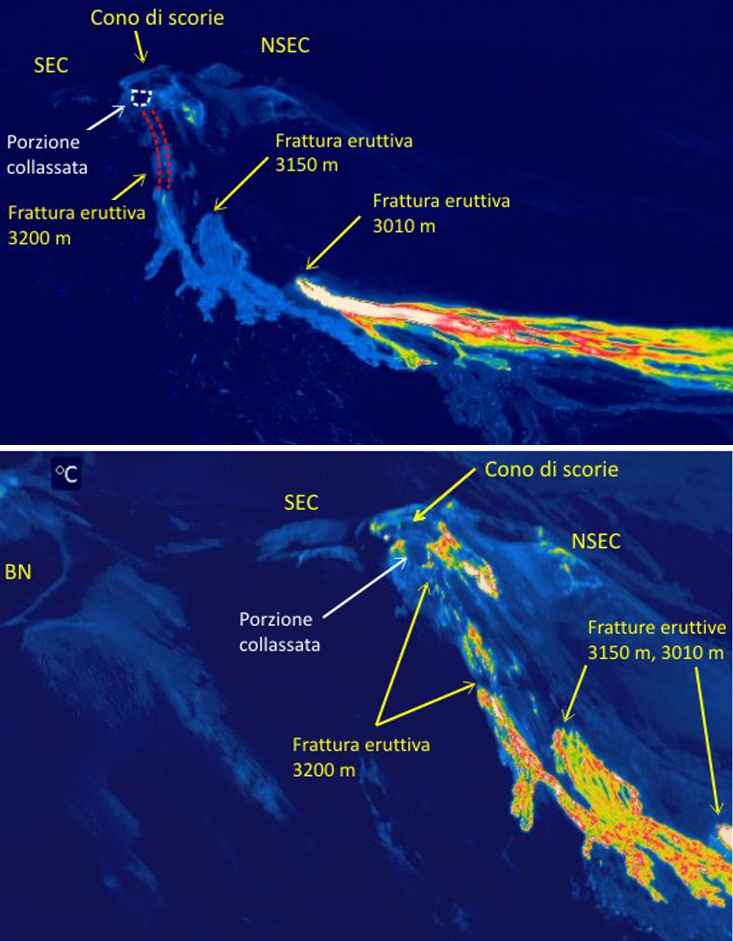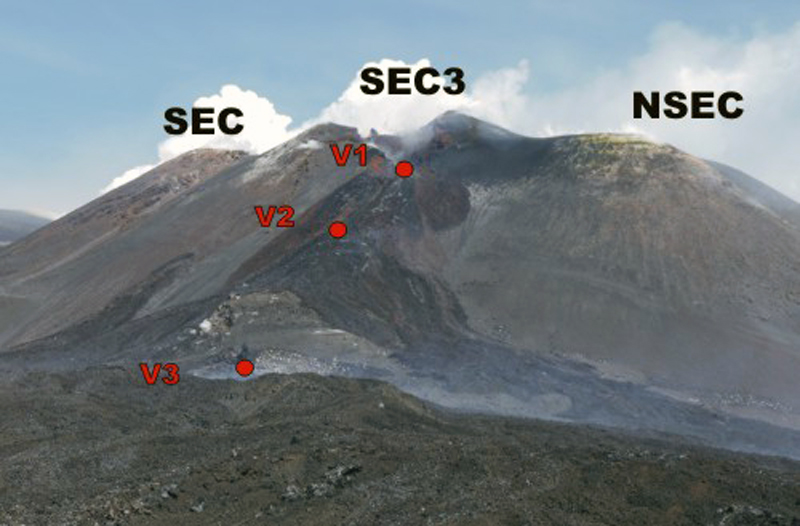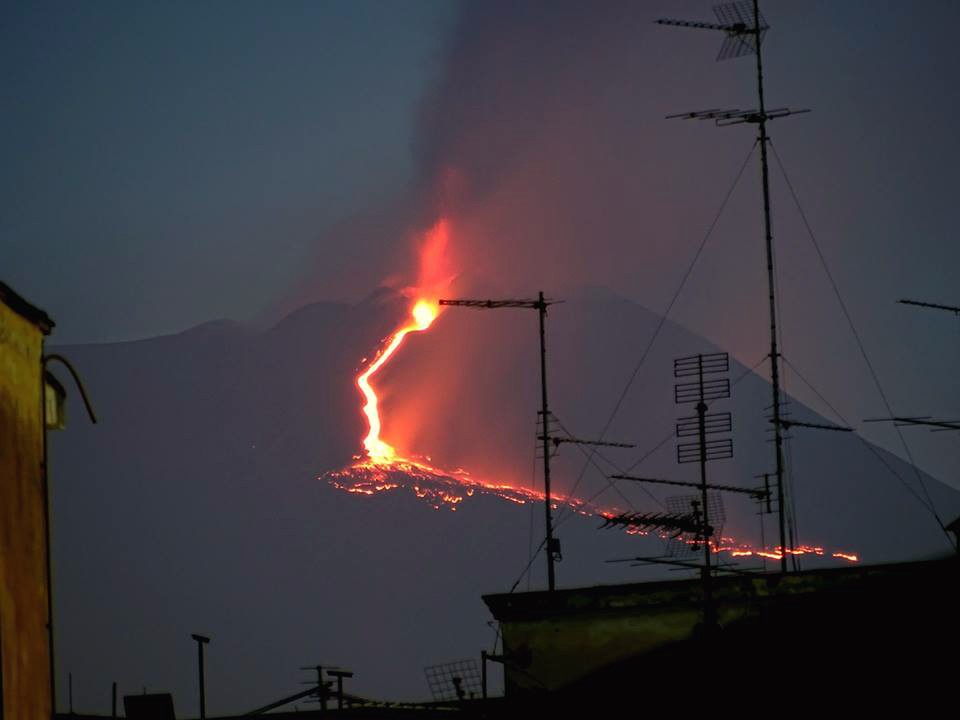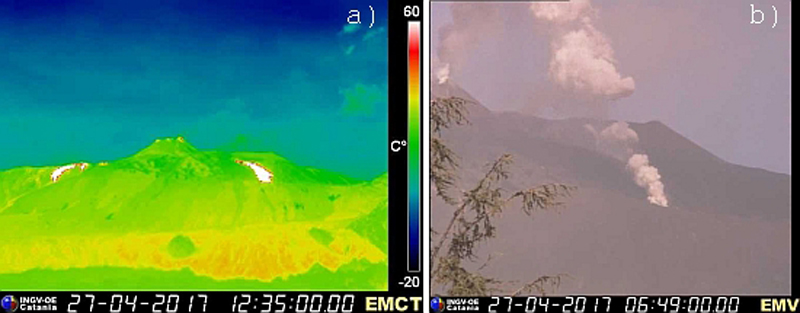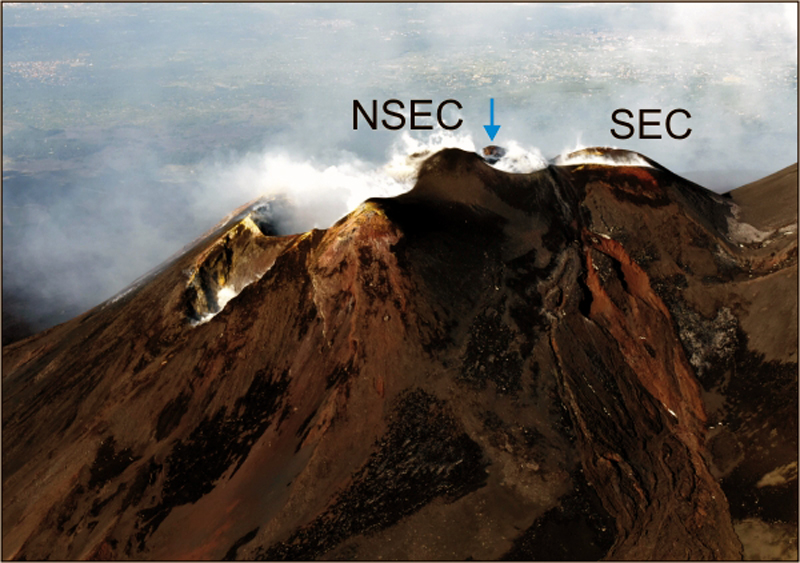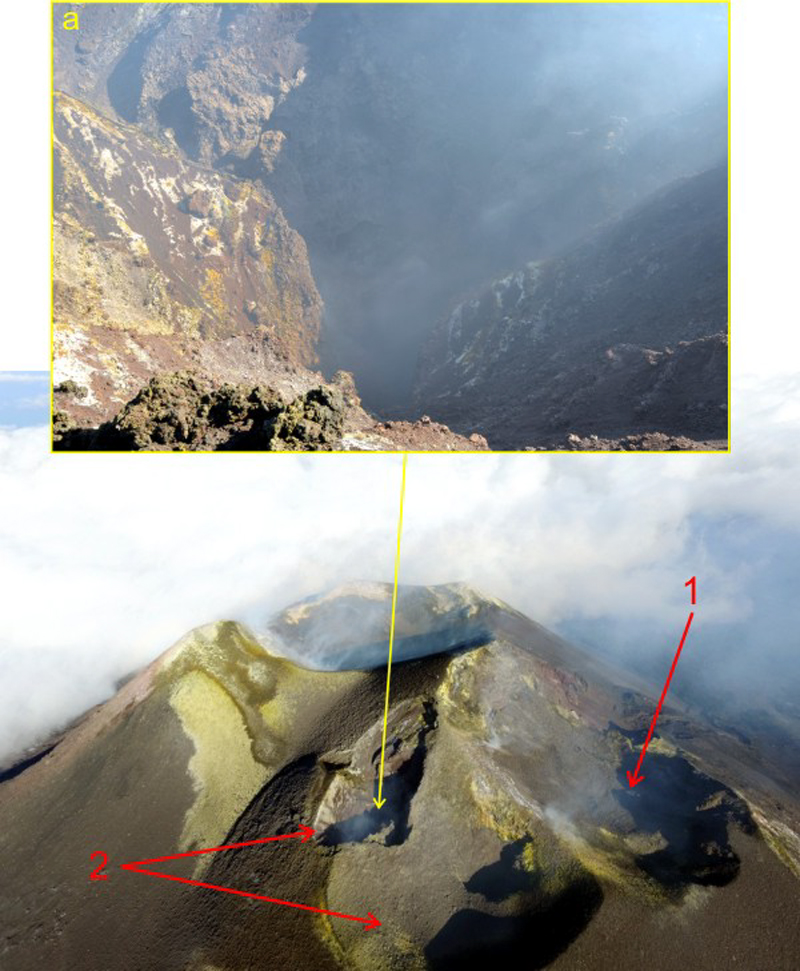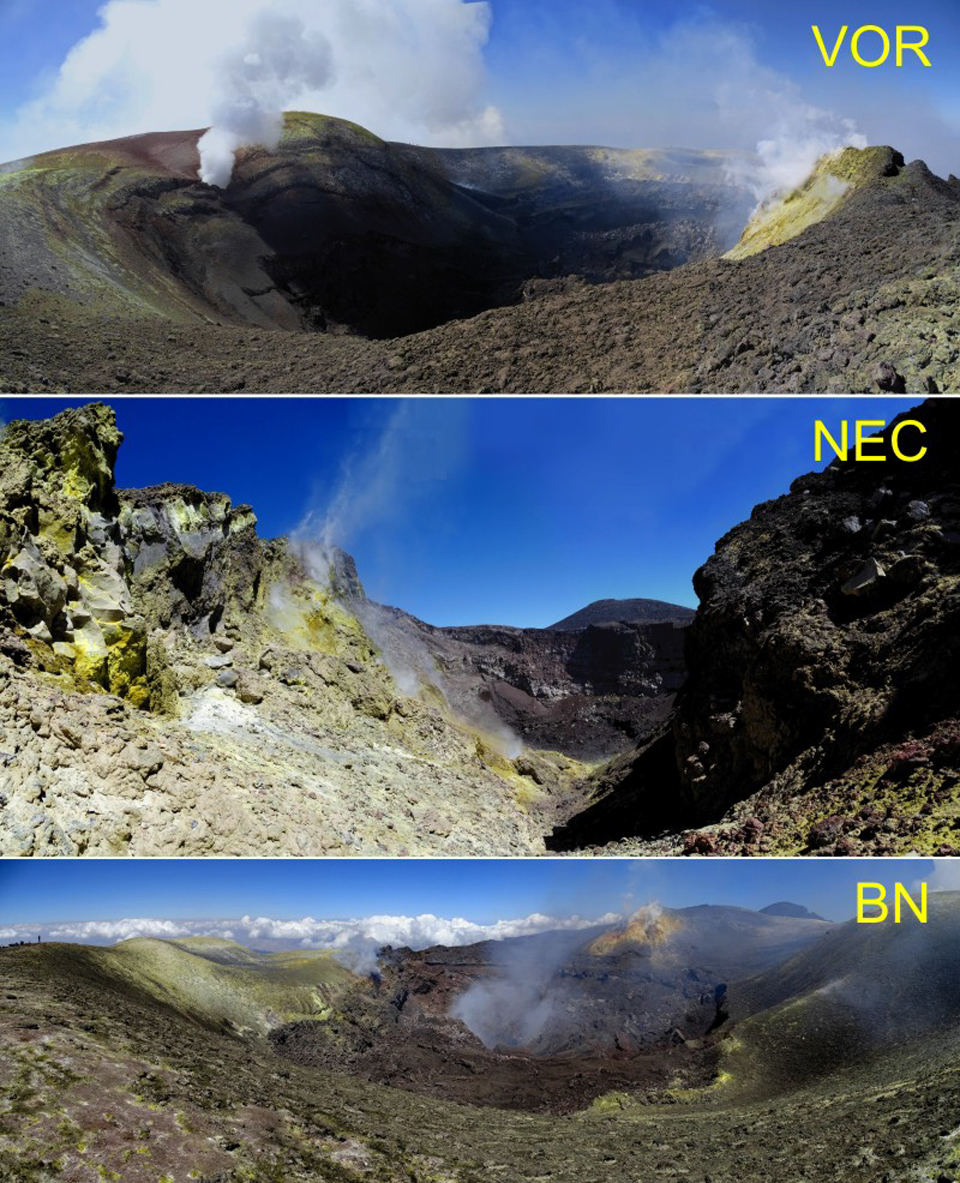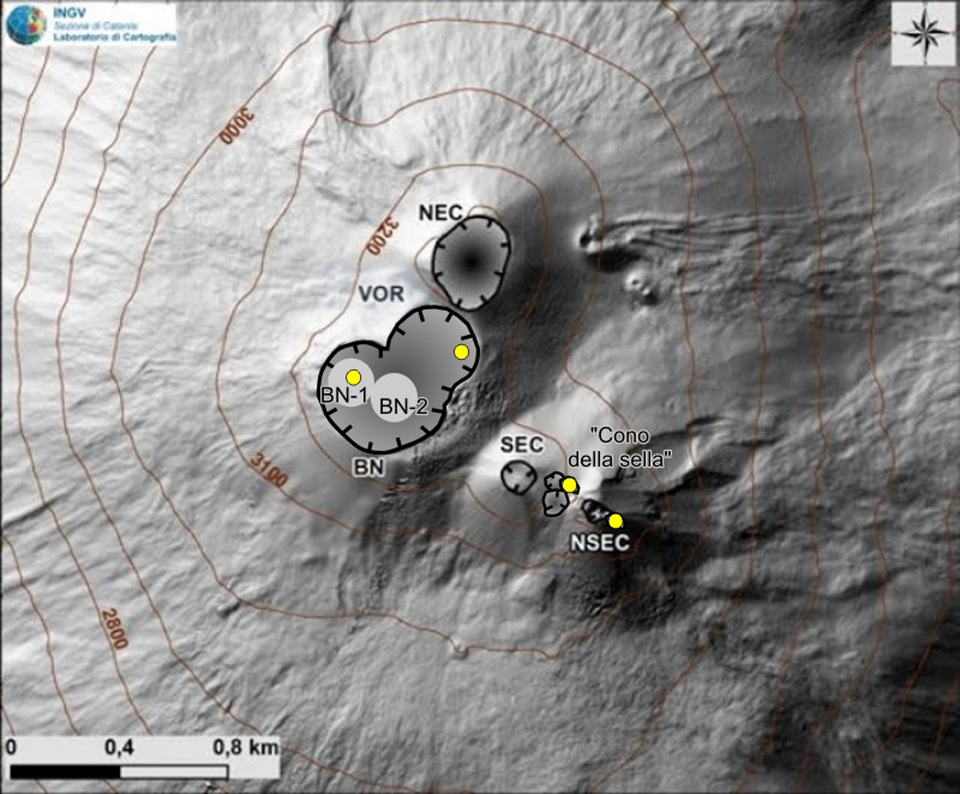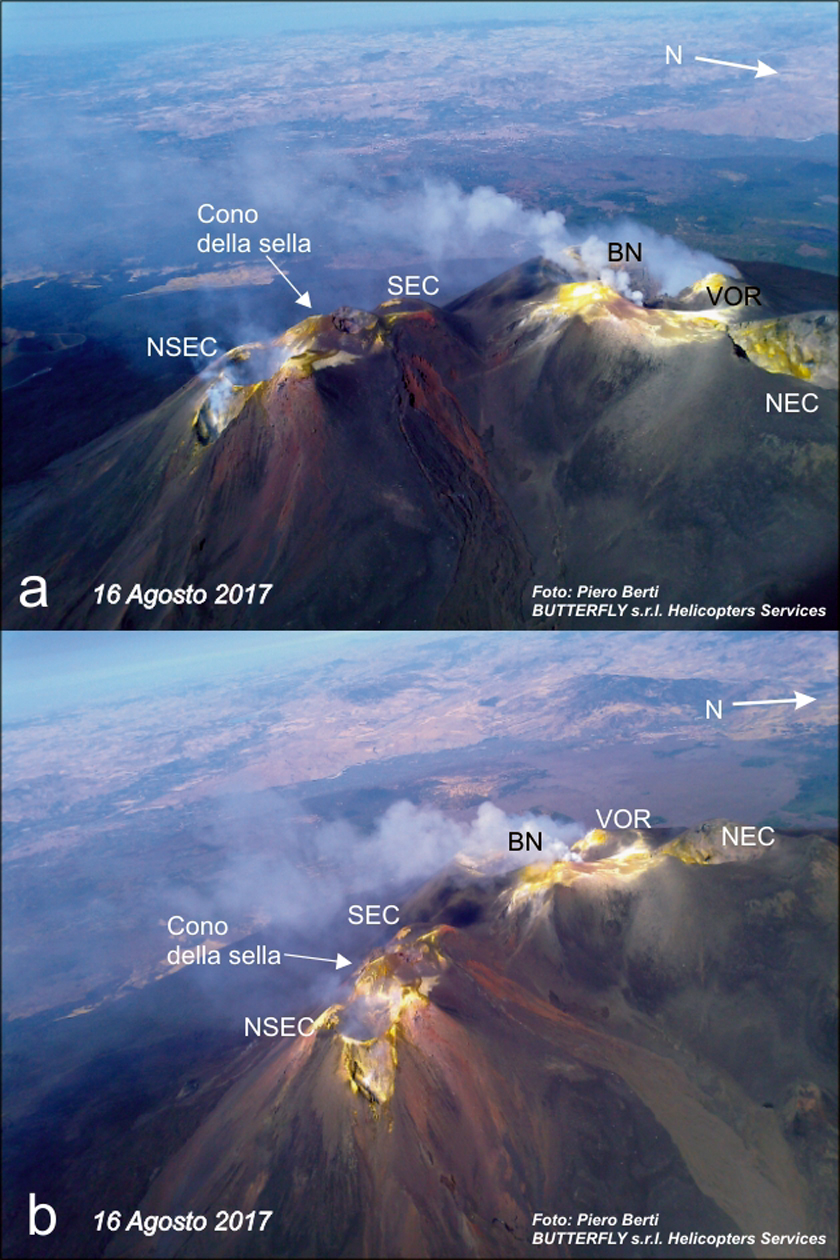Report on Etna (Italy) — October 2017
Bulletin of the Global Volcanism Network, vol. 42, no. 10 (October 2017)
Managing Editor: Edward Venzke.
Edited by A. Elizabeth Crafford.
Etna (Italy) Extensive lava flows during February-May 2017; new summit crater emerges
Please cite this report as:
Global Volcanism Program, 2017. Report on Etna (Italy) (Crafford, A.E., and Venzke, E., eds.). Bulletin of the Global Volcanism Network, 42:10. Smithsonian Institution. https://doi.org/10.5479/si.GVP.BGVN201710-211060
Etna
Italy
37.748°N, 14.999°E; summit elev. 3357 m
All times are local (unless otherwise noted)
Italy's Mount Etna on the island of Sicily has had historically recorded eruptions for the past 3,500 years. Lava flows, explosive eruptions with ash plumes, and lava fountains commonly occur from its major summit crater areas, the North East Crater (NEC), the Voragine-Bocca Nuova (or Central) complex (VOR-BN), the South East Crater (SEC) (formed in 1978), and the New South East Crater (NSEC) (formed in 2011). A new crater, the SEC3 or "saddle cone" emerged during early 2017 from the saddle between SEC and NSEC.
After a major explosive event in December 2015 (BGVN 42:05), activity subsided for a few months before renewed Strombolian eruptions and lava flows affected all of the summit craters during late May 2016 (BGVN 42:09). These events were followed by a lengthy period of subsidence and intense fumarolic activity across the summit that lasted until a new eruptive episode began at the end of January 2017. The Osservatorio Etneo (OE), which provides weekly reports and special updates on activity, is run by the Catania Branch of Italy's Istituo Nazionale di Geofisica e Vulcanologica (INGV). This report uses information from INGV to provide a detailed summary of events between January and August 2017.
Summary of January-August 2017 Activity. Minor ash emissions began from a new vent in the saddle between NSEC and SEC on 20 January 2017, followed by Strombolian activity a few days later. Activity intensified at the end of February when the first of several lava flows emerged from this vent, and then from several other vents on the S flank of the new, rapidly growing cone during March and April. By mid-March 2017, Strombolian activity, ash emissions, and lava flows had created a cone higher than the adjacent NSEC and SEC cones. The last effusive episode at the end of April 2017 sent flows down both the N and S flanks of the new cone from multiple vents. Intermittent weak Strombolian activity at the new summit area was associated with abrupt tremor amplitude increases during May, but no additional flows were reported. During June-August, fumarolic activity persisted at several crater areas, and minor ash emissions were observed a few times, but no major eruptive activity took place. The sharp increase in heat flow resulting from the lava flows of March and April 2017 are clearly visible in the MIROVA thermal anomaly plot of log radiative power for the year ending on 12 October 2017 (figure 186).
Activity during January-February 2017. Sporadic incandescence continued from the 7 August 2016 vent on the E side of VOR during January 2017, and minor ash plumes rose from the NSEC "saddle" vent on 20 January. Modest Strombolian activity began at the saddle vent that on 23 January and continued into February (figure 187). Small bombs were ejected onto the flank of NSEC and minor ash plumes quickly dissipated in the high winds near the summit. Also during February, steady subsidence continued at BN, especially in the BN-1 area (see figure 185, BGVN 42:09), where active degassing with minor amounts of ash was observed on 1 February (figure 187). Debris deposits from Strombolian activity at the saddle vent covered the S side of the pyroclastic cone and travelled to its base during the end of February.
During the late afternoon of 27 February, the Strombolian activity that began on 20 January from the saddle vent between SEC and NSEC rapidly intensified, and lava emerged from the vent and flowed down the S flank of SEC (figure 188). It slowed after reaching the flat ground at the base of the cone, and expanded slowly SE toward the older cones of Monte Frumento Supino. Intense activity that evening sent shards and bombs 200 m above the vent while the flow continued. Ash from the Strombolian activity dispersed NE, with minor ashfall reported in Linguaglossa and Zafferana. A new cone of pyroclastic material that formed around the saddle vent quickly grew to about the same elevation as the NSEC and SEC crater rims, approximately 3,290 m (figure 189). The lava continued to flow until 2 March 2017, when it stopped at about 2,750 m elevation with an overall length of 2,180 m, covering an area of 306 x 103 m2, for a total volume of slightly less than 1 x 106 m3.
Activity during March 2017. Sporadic ash emissions continued from the new saddle vent during early March 2017, accompanied by weak Strombolian activity during the night of 12-13 March. Intense degassing continued from VOR during March as well, with incandescent bursts visible on many clear nights. On the morning of 15 March the Montagnola webcam recorded a lava overflow from the saddle vent down the S flank of NSEC, and an intensification of explosive activity that caused the flow to reach the base of the complex at about 3,000 m elevation. During the day, it advanced towards Monte Frumento Supino; it had reached elevation 2,800 m by the late evening, overlapping significantly with the earlier flow from 27 February. Strombolian eruptions were nearly constant until late afternoon, and continued intermittently, along with ash emissions, for several days.
Shortly before 2300 UTC on 15 March (0100 on 16 March local time), a second new flow emerged from a vent near the base of the S flank of the new NSEC/SEC cone (at about 3,200 m elevation) and travelled SE (figure 190), splitting into two lobes. INGV personnel in the summit area reported a series of phreato-magmatic explosions at 0043 (just after midnight) along the lava front at an elevation of approximately 2,700 m along the W edge of the Valle del Bove. The contact of the active flow with the underlying snow caused several explosions. An INGV volcanologist suffered minor injuries during one of the explosions. Increased emissions also caused minor ashfall in Adrano and Santa Maria di Licodia (both about 17 km SW).
By the afternoon of 17 March 2017, the second flow had reached an elevation of about 2,600 m, near the base of the W slope of the Valle del Bove. INGV personnel at Monte Zoccolaro (1.5 km S) spotted a third flow on 18 March, located S of the other two (figure 191). The front had reached about 2,200 m elevation, and was responsible for some phreato-magmatic explosions during 18 and 19 March. Several avalanches of incandescent material reached the base of the slope at the edge of Valle del Bove as the flow fronts collapsed during 18 March. Two Landsat 8 Operational Land Imager images on 18 and 19 March captured evidence of the lava flows, an ash plume, and Strombolian activity during this episode (figure 192). By 19 March, the advance had slowed as the flows began to spread out over the valley floor. The flows into the Valle del Bove ceased on 20 March.
Strombolian activity and ash emissions ceased at the summit vent of the NSEC/SEC cone between 20 and 22 March 2017 leaving a new pyroclastic cone that rose above the adjacent NSEC and SEC cones (figure 193). Once the Strombolian activity had ended, yet another lava flow emerged from the base of the cone at an elevation of about 3,010-3,030 m, and spread into several segments, one of which flowed W around Monti Barbagallo (near the former Torre del Filosofo) and then turned SW following the valley between Monti Barbagallo and Monte Frumento Supino. By 26 March the front of this flow segment had reached an elevation of 2,300 m and travelled about 2.5 km from the vent. A second segment of the flow travelled E of Monti Barbagallo, following the earlier flows that had been active along the W slope of the Valle del Bove; it slowed and broke into several additional segments, reaching 1.3 km from the vent on 26 March, and advancing through the first week of April.
Activity during April 2017. The active lava flow continued WSW towards the cones of the 2002-2003 eruption from the vent at the base of the NSEC/SEC cone until it stopped advancing sometime during the night between 8 and 9 April (figure 194). Another new flow then emerged from the same vent on 10 April and was active for just over 24 hours. This flow travelled SE to the W edge of the Valle del Bove and moved a few hundred meters along the edge before stopping during the day of 12 April.
During the evening of 13 April 2017, Strombolian activity at the summit crater of the NSEC/SEC cone accompanied the emergence of flows from three vents along the S flank at elevations of approximately 3,200 m, 3,150 m, and 3,010 m which headed S and SE. The upper flows were active for only a few hours, but the lower flow continued SE towards the Valle del Bove and had overlapped the 10-11 April flow by the next day. The active front of the flow was at an elevation of 2,400 m on the western slope of the Valle del Bove, just north of the Serra Giannicola Grande. A flyover on 14 April revealed the extent of the fracture system on the flank of the NSEC/SEC complex from which the numerous flows emerged (figure 195). The flow rate diminished during the day of 15 April, and the flow stopped sometime during the next night.
A thermal anomaly appeared at the S edge of the NSEC/SEC summit vent, which INGV began calling SEC3, on the morning of 19 April. Weak Strombolian activity from the vent was followed by the emergence of a lava flow from the S side of the crater rim that flowed down the S flank of the cone. Dense, brown ash emissions about an hour later accompanied the re-opening of three vents on the S flank from which new lava flows emerged (figure 196). Lava jets rose tens of meters above the crater rim for about an hour in the afternoon. The lava flows from the three vents formed into two branches moving down the S flank (figure 197), then turned E and spread over the W slope of the Valle del Bove; by 20 April they had reached an elevation of 1,950 m. Explosive activity ceased at SEC3 that afternoon, and the flows stopped advancing sometime during the night of 20-21 April. Observations of the summit of SEC3 on 22 April revealed a N-S trending graben formed in the S rim of the summit crater about 100 m long, 10 m wide, and several tens of meters deep.
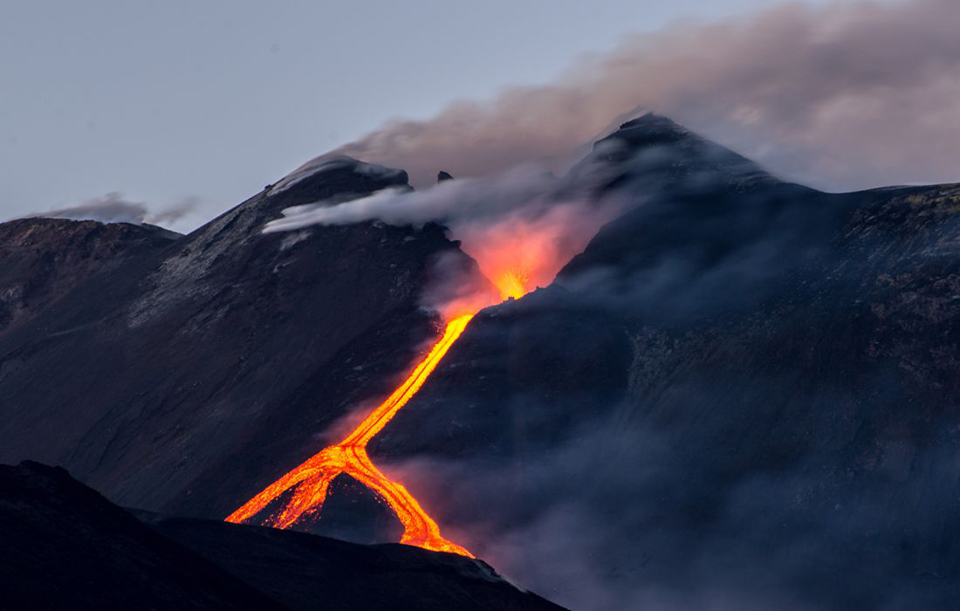 |
Figure 197. Lava flows from the summit crater of the new cone (SEC3) at Etna on 20 April 2017. Photo by Salvatore Allegra/Anadolu Agency/Getty Images/CFP, published in Globaltimes, 20 April 2017. |
The next eruptive episode began late in the day on 26 April 2017, with a slow-moving lava flow that emerged from the summit vent of SEC3. The flow made it part way down the S flank before another flow from the same vent covered it and reached the base of the flank. Strombolian activity began at the summit vent during the late evening while the flow continued to spread SE toward the Valle del Bove (figure 198). Strombolian activity intensified during the early hours of 27 April and a new vent opened at the summit immediately N of the first one. At around 0220, two new eruptive fractures opened on the N flank of SEC3, from which lava flowed N toward the Valle del Leone (figure 199). At daybreak, an ash plume was visible about 1.5 km above the summit drifting E. Phreato-magmatic explosions were observed in the Valle del Leone when the northern lava flow encountered snow on the ground. Strombolian activity ceased around noon and the flows on both the N and S flanks had ceased by the following morning.
Activity during May-August 2017. Intense degassing with incandescence at night continued from the vent at VOR throughout April and into May 2017. At NEC, degassing continued from the large fumarole field at the bottom of the summit crater. No further lava flows erupted during May 2017, however, there were several short, high-energy tremor episodes in the area around SEC3. During May, more than 35 episodes of transient increases in tremor amplitude were recorded by INGV seismic instruments (figure 200). During 15-18 May, there were 11 episodes of Strombolian activity from the northern SEC3 summit vent, repeated at regular intervals of about every 8-9 hours. Lava fragments were ejected outside the crater rim and rolled down the flanks (figure 201). Each episode was accompanied by a sharp increase in volcanic tremor amplitude. Eight additional episodes of weak and discontinuous Strombolian activity occurred between 25 and 28 May at intervals ranging from 3 to 14 hours, each lasting about an hour, and accompanied by increased tremor amplitude. A short sequence of dense ash emissions from BN-1 on the morning of 31 May was the only ash plume reported during May.
Weak and discontinuous Strombolian activity resumed at NSEC on 6 June 2017, along with a sudden increase in tremor. The activity lasted until 9 June and included four episodes of roughly one hour each. Very little material fell outside the crater rim during these events. Vigorous degassing and nighttime incandescence continued at the VOR vent during June. INGV-OE personnel inspected the summit on 23 and 29 June, and 2 July 2017. High temperatures (around 600°C) were recorded at the VOR vent on 23 June. The other fumarolic areas, especially in the fracture field between NEC and VOR, were around 250°C, cooler than when last measured on 31 August 2016. Occasional weak ash emissions began on 24 June from SEC3; they lasted for a few days and quickly dissipated near the top of the cone. They ceased late in the evening of 28 June.
In a survey by drone on 4 July 2017, INGV-OE personnel noted widespread degassing along the rim and E side of the SEC3 crater. The vent that had formed during 27 February-26 April appeared to be blocked (figure 202). During the late morning of 9 July, the vent that had formed during 26-27 April emitted a small amount of red-gray ash. The next day a small amount of ash emerged from the base of BN-1. Incandescence was frequently observed at night from the VOR vent and from the NSEC. Degassing was observed regularly throughout the month at the VOR vent, the bottom of BN-1, and NEC (figure 203).
Occasional weak, diffuse ash emissions continued during August 2017 from the bottom of BN-1. INGV-OE scientists attributed this to collapse at the base of the crater. Limited degassing was noted at NEC, but persistent degassing continued from the 7 August 2016 vent at VOR, and from a vent on the E side of NSEC in addition to a vent at the SEC3 summit (figures 204 and 205).
Geological Summary. Mount Etna, towering above Catania on the island of Sicily, has one of the world's longest documented records of volcanism, dating back to 1500 BCE. Historical lava flows of basaltic composition cover much of the surface of this massive volcano, whose edifice is the highest and most voluminous in Italy. The Mongibello stratovolcano, truncated by several small calderas, was constructed during the late Pleistocene and Holocene over an older shield volcano. The most prominent morphological feature of Etna is the Valle del Bove, a 5 x 10 km caldera open to the east. Two styles of eruptive activity typically occur, sometimes simultaneously. Persistent explosive eruptions, sometimes with minor lava emissions, take place from one or more summit craters. Flank vents, typically with higher effusion rates, are less frequently active and originate from fissures that open progressively downward from near the summit (usually accompanied by Strombolian eruptions at the upper end). Cinder cones are commonly constructed over the vents of lower-flank lava flows. Lava flows extend to the foot of the volcano on all sides and have reached the sea over a broad area on the SE flank.
Information Contacts: Sezione di Catania - Osservatorio Etneo, Istituto Nazionale di Geofisica e Vulcanologia (INGV-OE), Sezione di Catania, Piazza Roma 2, 95123 Catania, Italy (URL: http://www.ct.ingv.it/it/); NASA Earth Observatory, EOS Project Science Office, NASA Goddard Space Flight Center, Goddard, Maryland, USA (URL: http://earthobservatory.nasa.gov/); MIROVA (Middle InfraRed Observation of Volcanic Activity), a collaborative project between the Universities of Turin and Florence (Italy) supported by the Centre for Volcanic Risk of the Italian Civil Protection Department (URL: http://www.mirovaweb.it/); Global Times, http://www.globaltimes.cn/galleries/774.html.


